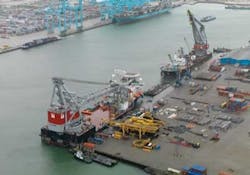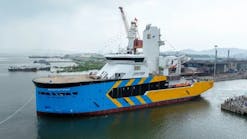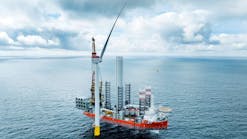Jeremy Beckman
Editor, Europe
Installation contractors must constantly anticipate energy developments. The widespread additions to the global construction vessel fleet of recent years were driven by offshore operators’ shifting priorities.
When Seaway Heavy Lifting started conceptual studies for theOleg Strashnov in 2005, the company identified the need for a dual-draft, fast-transit crane vessel, capable of criss-crossing between the world’s remoter regions to take on mid-range development projects.
Oleg Strashnov being launched from the shipway at IHC Merwede’s yard in Krimpen an den IJssel.
These criteria still apply, although the vessel’s maiden assignment will be in Seaway’s back yard, the southern North Sea, installing structures for Statoil’s Sheringham Shoal wind farm project off the English east coast.Oleg Strashnov will return to this region in the summer for its first offshore project, lifting the topsides for RWE’s Clipper gas platform.
Supply issues
Construction of the vessel started in late 2007 at the IHC Merwede shipyard in Krimpen aan den IJssel, east of Rotterdam. Reliable delivery was one of the factors in the local award of this contract, rather than a yard in the Far East, although the vessel was eventually delivered nearly a year behind schedule.
According to Seaway’s CEO Martin Spaans, various factors contributed to the delay. “Understanding the complexities of this ship was an issue, as was scheduling of the yard’s activities – the contractor underestimated the progress that would need to be achieved. And there were some problems with interfaces…but this was partly due to the yard going through a learning curve. The IHC Shipyards group had bought this new location in Krimpen, so the site had to be craned up, and the various disciplines integrated.”
On the other hand, there were advantages in terms of quality, with most of the equipment items provided by local subcontractors, aside from the winches, which came from Germany; the power generation/propulsions systems, supplied by Wartsila LIPS; and the slewing platform and tub for the vessel’s main derrick crane, fabricated in China. Some of the steel structures, which were also fabricated in China, had to undergo extensive repairs, but otherwise, Spaans says, “the final overall quality of equipment was OK.”
Oleg Strashnov is the world’s second largest monohull crane vessel, Spaans claims, with the Gusto MSC-designed, fully-revolving main crane hook capable of single lifts of 5,000 metric tons (5,511 tons) at heights up to 100 m (328 ft). The auxiliary crane can lift loads up to 800 mt (882 t) at 132 m (433 ft): this combination allows the vessel to undertake a range of offshore oil and gas projects from dual-hook upending of large jackets to heavy deck installations. The high level of control provided by the DP3 dynamic positioning system also facilitates installation of large, heavy subsea structures and TLP/Spar foundations and topsides.
The vessel has an overall length of 183 m (600 ft), a breadth of 47 m (154 ft), a depth from deck of 18.2 m (59.7 ft), and a draft of 8.5-13.5 m (27.9-44.3 ft). Power is provided by six main 4.5 MW engines, and propulsion/maneuvering via two 5 MW underwater aft thrusters; two azimuthing 3.5 MW DP thrusters amidships; and two 1.01 MW bow thrusters. This package, allied to the vessel’s novel hull shape (patent pending) allows it to reach transit speeds of 14 knots, 5 knots faster than Seaway’s existing crane vesselStanislav Yudin.
Since construction started, there have been few changes to the original equipment specifications or layout. Where possible, Seaway tried to cover all eventualities prior to awarding the contract. “We spent more time on this process, and took the design further, than most other shipbuilders would do,” Spaans explains.
“The actual cost outcome was within 2% of our budget. At $500 million, it is admittedly rather expensive, but the order was placed when shipbuilding prices were at their peak.” The range of high-spec equipment was another factor. “In the design phase, we looked at what our competitors were doing with their next-generation vessels. We drew envelopes around all the features we thought might be needed in future – higher deck capacity, more efficient dynamic positioning (DP), faster speed. That’s one reasonOleg Strashnov is more expensive than other vessels of comparable size.
“Other vessels have DP but no anchor spread – ours has both, which gives us the flexibility to change the ship as and when circumstances demand. Some multi-role crane ships can handle 4,000-metric ton [4,409-ton] lifts, but not 5,000 mt [5,511 t] like this one. Ours can lift more than most monohulls, and it is also equipped with a whip hoist to accommodate flare stacks and light structures up to 800 mt at heights of 134 m above the water line.
“Another feature is the under-deck firing line, which opens up the deck area for construction. This is a fallback option – if the world economy leads to a shortage of crane work, we can provide S-lay. The beauty of having this spread below deck is that it won’t interfere with crane operations, but for the time being, our focus will remain on lifting.”
Commissioning checks
Oleg Strashnov was launched by IHC Merwede in October 2009. Last May, the vessel sailed west from the yard to its outfitting location in Rotterdam’s Waalhaven, and for installation of the main crane. En route the vessel passed successfully under various bridges despite limited leeway (only a couple of meters in width and height). This is another advantage, Spaans points out, when the ship comes to negotiate the entrances to the Suez Canal and Black Sea (Bosphorus Strait). “We simply lower its A-frame, enabling it to just pass under the bridge. Other vessels of our capacity have mast cranes which would have to be disassembled because they cannot fold.”
(top)Oleg Strashnov undergoing sea trials, ahead of its first installation project in the UK North Sea. (bottom) The main crane being readied for installation at the quayside in Rotterdam, with Oleg Strashnov in the background.
Last September, the vessel transferred to another location in the Maasvlakte waterway in southern Rotterdam for sea trials and commissioning/testing of the main crane. The trial program for the crane lasted over two months, progressing from minor lifts to proof loading, towards the end of the commissioning stage. Then the heavier lifts were staged, climaxing in a 5,000-mt test load at the 13.5-m operational draft in March.
“All the sea trials were performed in November,” says Seaway’s COO Wim van der Velde. “We checked the dynamic positioning system for workability, and the results were pretty impressive. The design of this system was based on certain assumptions, but when it came to validating the reality, the performance was quite a bit better than in the design phase.
“This is a DP3 vessel, with an enormous amount of built-in redundancy. In normal operations, you don’t approach the limits of its capability. But if there is only the slightest possible weather window, this vessel can operate, unlike other ships of its size. Our thruster system makes more optimum use of all the thrusters by means of an innovative switching technology.”
Oleg Strashnov’s patented hull shape allows for smoother transit through rough seas than conventional monohulls or semisubmersibles, he adds. The hull shape also facilitates dual-draft operations. At the normal transit draft of 8.5 m (28 ft) it will typically perform piling operations and lighter-weight subsea lifts. Lowering the vessel to a draft of 13.5 m brings the wider parts of the hull into the water, rendering the vessel suitably stable for high-end lifts.
Future applications
Although theStanislav Yudin has worked traditionally in Europe, North Africa, the Middle East and India, Seaway has always looked to go global, according to Business Development Manager Aart Ligterink. This will now be more feasible, owing to Oleg Strashnov’s fast transit speed.
“We will focus it on bigger projects. While the vessel will work in the North Sea, we aim to pitch it at more ‘remote’ regions where no other heavy-lift vessels are permanently based, such as eastern Canada, Brazil and Argentina. We also see opportunities in Southeast Asia and offshore Australia, where there is definitely scope to perform at least one project a year.
“In the UK sector, we see more demand for jackets and substations for wind farms, thanks to the government’s subsidies, with the substations gaining in weight to 4,000 – 5,000 tons [4,409-5,511 tons]. That market was not there when we committed to this venture in 2005-07.”
“The market in deepwater installations will continue to develop. In Norway, we see the need to install bigger subsea modules such as compressor stations and seabed separation units weighing around 2,000 mt [2,204 t] – this fits our scope of 500-2,500-mt [551-2,756 t] for subsea lifts. For setting structures down on the seabed in water depths of 2,500 m [8,202 ft], this vessel provides a very big deck space, which means it can transport the entire structure to the field, then lift and lower it into the water either using the crane or via specialized winches.
“We are also looking with our clients at the possibilities for mooring projects involving mid-size Spars and mini-TLPs in the Gulf of Mexico. This would be perfect forOleg Strashnov, which could install the entire platform (topsides included) and the suction piles, then pay out fiber rope moorings to connect them to the hull.”
Offshore Articles Archives
View Oil and Gas Articles on PennEnergy.com








